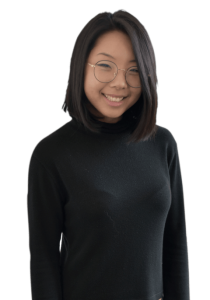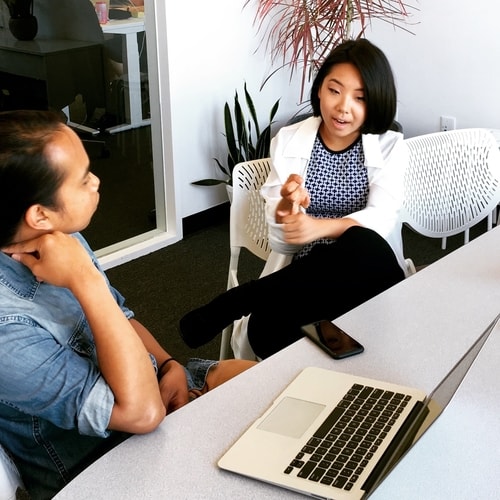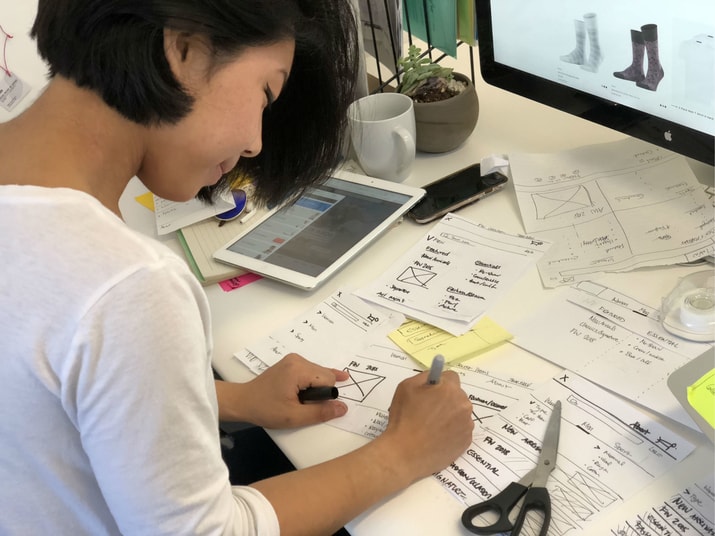
Btrax Design Company > Freshtrax > Converng with U...
Conversing with UI: A UX Designer’s Journey Through Trends [btrax Voice #1 Mimi Yu]
btrax voice is a series highlighting a different employee at our company each time. For our first installment of the btrax voice on our blog freshtrax for the US side, we sat down with Mimi Yu, one of our UX Designers.
Mimi shares her thoughts on current design trends and reflects on her experiences and how she came to be in design, where she is today, and how she wants to grow and learn in the world of design.
Who is Mimi?
 btrax Voice: Mimi Yu
btrax Voice: Mimi Yu
Job Title: UX Designer
Company: btrax, Inc.
Graduating from University of California Davis with a major in Sociology and a minor in Philosophy, Mimi Yu has always been interested in UX Design, even if she didn’t know it then. After working in marketing and sales, she sought out her passion in UX Design by going through San Francisco’s General Assembly Immersive UX Design program. She joined btrax with the goal of bridging the gap between different cultures, influenced by her roots as a Korean American woman.
How did you become interested in UX Design?
I guess I’ve always subconsciously been interested in UX Design, but when looking back at it, two main things pointed me in that direction. While I was working in sales for a startup, our product was constantly evolving. We had a few target customers for our product and when I first joined, those customers held equal importance to our company.
After doing some research on both targets, we determined that we needed to focus on just one of the targets since they actually had the means to implement the software we were selling. After that, we shifted everything, including the design of the product, to focus on what that customer needed. I thought this entire process was so cool and interesting.
We’d work closely with the product designer and he’d walk us through the shift of the product. The process of taking what my team knew, as sales, and that insight and data having an affect on where we go as a product and company, I thought “I want to be on that side.” It seemed more in the cockpit and I wanted to be in the heart of it.
The other main factor was the influence of a good friend, Mike, who is a product designer. I just loved who he is as a person. In the sales position I was in, I felt that I was at a crossroads and wanted to be more of a “Mike” than a salesperson.
He and his friends are thoughtful and would always talk about design when we were out at bars. I love the passion Mike had and I felt it was a special community and so it really got me into it.
The title of “UX Designer” can mean something different in every company, how is being a UX Designer at btrax unique?
At a lot of larger companies, if you hear “UX” it means you’re focused on one product for one or part of the design process. Here at btrax, we take the broadness of UX to heart.
Since we have a small team, I’m able to work on all aspects of product design. For one project, I may do research or test assumptions with users. On another day, I’m thinking through user flows and designing interactions.
The scope of what we do here at btrax makes it unique, since our specialty is working with Japanese companies. As a designer, it’s such a challenging but crucial thing to be in a place where your assumptions are constantly challenged.
It helps you expand your perception beyond the limits of what you think is “true.” That’s something I’m very lucky to have here at btrax.
While working in SF, I’ve found that many companies can be homogenous and lack diversity in race or gender and sexual identity. At btrax, you have access to diverse perspectives from coworkers and clients across all these areas.

Explain your design process to me.
I usually start with the following questions:
- Who is the user?
- What is the problem they have?
- Why is this problem important to them?
- What do we know so far about them?
- What are our assumptions?
- How does our solution address the problem in a unique or effective way?
An automobile company we worked with was struggling with massive amounts of demographic data but few actual insights into their customers’ needs. They asked us to validate their assumptions around the lifestyles, motivations, and needs that were driving users to their product. Determining these through focus group interviews helped highlight how to improve and tighten their current experience.
Answering those questions is one of the hardest parts of the process. Once you have that knowledge, it’s much easier to see where you can intersect user needs with a client’s business goals. After that, it’s also easier to think through how a solution would flow and engage with the user.
Even when these questions are initially answered, I try to continue to ask them throughout the whole process. You sort of have to play devil’s advocate. Often, at the start of the project, everyone wants to go-go-go, and I want to GO too, but there has to be someone to step on the brakes and ask, “what do we actually know about the user and what are we just hoping is true?”
I think that’s the benefit of working with people across departments, especially our Innovation Booster (IB) team [btrax service team that supports companies interested in expanding globally to build the mindset for global innovation through the service design process]. They will question EVERYTHING! That’s the kind of attitude I try to bring to my own process.
UX is constantly changing…how do you stay current on UX topics?,
A lot of reading and talking to people. The design community is my number one influence. I’m a part of a few FB Groups where people post on design topics and ask questions. Meetups are great for seeing what everyone is focused on lately. There’s one called Designers + Geeks that I love and follow.
I’m lucky to have mentors who coach me on design and life in general. Also, just living in the SF Bay Area and hanging with friends in the industry. The ideas, innovation, and passion here are crazy. It’s ground zero.
Where do you think UX is going in terms of trends?
The biggest trend I’m noticing is that user experiences are moving offscreen. We’re seeing it everywhere, from voice interfaces and the smart watch. [This trend is so prevalent] I almost don’t even think about it anymore. I believe this makes it even more crucial to know your user’s behavior, lifestyle, and needs.
I would also say, we’re eventually going to merge with this technology on an intimate level. I already see this with Google Home and Alexa being in bedrooms and living rooms, basically having access to private conversations. I think that delves into ethics and immediacy… As designers we have to consider how you influence people to act a certain way.
Another trend I’ve experienced and thought a lot about while working at btrax is conversational UI. I come from a writing background, and working at btrax I often write the microcopy in interfaces. It’s forced me to think about the dialog onscreen and how that pertains to the user’s experience.
You come to think through a flow as a conversation, where the interface is an entity asking you a question and you’re responding, choosing your own adventure.

In your opinion, how did these trends evolve?
My take on it is that millennials (myself included) put out a lot of information about ourselves. We’re great branders and are constantly thinking about how we portray ourselves online and offline. Because of this, I think everything has become so personalized.
Like when the iPhone came out, it was a personalized device that let you download apps you wanted and create collections of these to reflect your lifestyle and tastes. It’s almost like you’re building a digital empire of your own life.
We expect technology to keep up with us at every step of our daily lives, so its no wonder we’re moving off of interfaces into less tangible experiences, like voice. I think the technology will become more immersive as our expectations increase.
With Conversational UI, it’s also a case of rising expectations. Moving from physical buttons to tappable, flat buttons to things like chatbots shows that technology is increasingly becoming more human.
In the past, technology was seen as a separate tool. Now, we expect the interface to cater to you and flow with you. It’s an assistant who’s expected to communicate with you on your terms using conversation.
How do you incorporate this or how do you think about this within your design process at btrax?
In general, the “trend” that I’m constantly thinking about at btrax is Conversational UI. Since we don’t have a designated UX writer and because our company and clients are so bi-cultural [internal and external], using precise language is crucial to connecting user and client needs.
How would you like to grow as a UX Designer at btrax?
There’s so many things I’m looking to improve on! I want to become more T-shaped in skill-set and grow my prototyping skills, eventually getting better at designing interactions. At the same time, I’d love to get deeper into research, to be able to measure the impact and effectiveness of design decisions.
Our service teams at btrax are so competent with analytics. I’d love to build my knowledge and gain more experience analyzing user behavior.
Is there an element of UX that you’d like to try or explore more of at btrax?
An emerging technology that has huge potential and I’d love to explore more about is Augmented Reality (AR). I’ve read so much of how it’s being implemented through UX and it’s fascinating. I’m interested to see what kinds of problems it can help solve and I’d love to spend some time unpacking one of those problems.
I’d also love to get more experience designing across cultures. I know this will come with more time at btrax. I’m excited about that.







